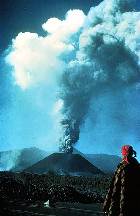Plate Tectonics
Plate
tectonics is the theory that the earth's lithosphere is broken
into large, rigid sections or plates that move horizontally across the
earth. The movement of these plates can affect the earth's climate
in many ways:
- by changing the distribution of the continents between the poles and equator--average temperature increases as a landmass moves toward the equator
- by lifting up landmasses (mountain-building)--average temperature decreases as the altitude of a landmass increases
- by the release of greenhouse gases and dust particles during seafloor spreading and the eruption of volcanoes--greenhouse gases such as sulfur dioxide (SO2) and carbon dioxide (CO2) may lead to temperature increases, while dust particles may increase cloudiness and lead to temperature decreases.

Photo: Volcano in Paricutin, Mexico in 1943. Photo courtesy of NGDC/NOAA.
HTML code by Chris
Kreger
Maintained by ETE
Team
Last updated
April 28, 2005
Some images © 2004 www.clipart.com
Privacy Statement and Copyright © 1997-2004 by Wheeling Jesuit University/NASA-supported Classroom of the Future. All rights reserved.
Center for Educational Technologies, Circuit Board/Apple graphic logo, and COTF Classroom of the Future logo are registered trademarks of Wheeling Jesuit University.